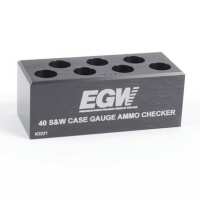
Our Case Gauge Ammo Checkers are machined from solid 6061 T6 aircraft grade aluminum.Our gauges are made to SAAMI miniumum spec.While some companies use boring bars to make chamber checkers, we use the actual Clymer reamers that are used to chamber barrels.Anodized matte black for durability.Measures min case diameter.Measures max overall length. We have found our gauges extremely helpful when reloading ammunition. We recommend the following procedure to help alleviate any issues while reloading. The following information is general information and not caliber specific. We always recommend consulting your reloading manual:
Checking Case Length: Auto pistol cartridges headspace on the case mouth and not the case rim as revolver cartridges do. To make certain your cases are not too long, do the following:
1. Resize and deprime the case. 2. Drop the case inside the holes in our case gauge. 3. If your cases are flush with the top of the gauge, the cases do not need trimming. However, if they do protrude, then trimming may be required.
Checking Proper Bullet Seating Depth: 1. Install the bullet into a correct length case and drop it in to our gauge. 2. If the case is flush with the top of the gauge, the seating depth is correct (for that shape, style, length and weight bullet). 3. If the case protrudes slightly, remove the cartridge and reseat the bullet just a fraction of an inch deeper into the case and try again. If the case is still protruding, seat the bullet deeper and stop when the case sits flush with the gauge. 4. With the cartridge still in the gauge, hold it in place with your finger and turn the gauge over. The tip of the bullet should not protrude beyond the bottom of the gauge. If it does, the bullet is not seated deep enough and should be set deeper. 5. If the case has been properly resized, the length is correct, and the bullet is seated to the proper depth, you should be able to turn the gauge over and have your cartridge fall out by gravity alone. Warning: This product may be alloyed with trace amounts of lead and other elements which are known to the State of California to cause reproductive harm and cancer. To prevent exposure, do not alter the product by welding, grinding, etc. For more information, go to www.P65Warnings.ca.gov.
Location:
52 BELMONT AVE,
QUAKERTOWN
Pennsylvania
18951

